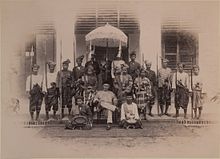Ahmad al-Muadzam Shah of Pahang
| Ahmad al-Muadzam Shah أحمد المعظم شاه |
|||||
|---|---|---|---|---|---|
| Sultan of Pahang | |||||

Sultan Ahmad al-Muadzam Shah and his personal attendants, 1897.
|
|||||
| Raja Bendahara of Pahang | |||||
| Reign | 10 June 1863 – 8 August 1881 | ||||
| Predecessor | Tun Mutahir | ||||
| Sultan of Pahang | |||||
| Reign | 16 August 1881 – 13 April 1909 | ||||
| Coronation | 25 September 1884 | ||||
| Successor | Sultan Mahmud Shah | ||||
| Born |
23 May 1836 Pulau Maulana, Pekan, Pahang, Federated Malay States, British Malaya |
||||
| Died | 9 May 1914 (aged 77) Istana Pantai, Kuala Pahang, Pahang |
||||
| Burial | 11 May 1914 Royal Cemetery, Kampung Marhum, Kuala Pahang, Pahang |
||||
| Spouse | Cik Besar Yang Atur bt Abdullah Cik Amah bt Jamut Engku Besar of Terengganu Tengku Ampuan Tua Tun Besar Fatima bt Tun Muhammad Che’ Ungku Pah binti Dato’ Temenggong Sri Maharaja Tun Ibrahim Encik Besar Zubaida bt Abdullah (Tan Lai Kim) Cik Hajjah Fatima binti Haji Muhammad Talib Cik Kusuma binti Tok Minal Daeng Koro Cik Santoma Cik Wan Mandak Kiri Cik Halima Cik Bakai Cik Mah binti Awang Tukang Cik Maimuna Cik Fatima Selat |
||||
| Issue | Tengku Long (d/o Fatima) Tun Muda Besar (s/o Kusuma) Tengku Long Mahmud (s/o Pah) Tun Salama (d/o Fatima) Tengku Ali (s/o Santoma) Tengku Dalam (d/o Fatima) Tengku Abdullah (s/o Kusuma) Tengku Nong Fatima (d/o Fatima) Tengku Sulaiman (s/o Kusuma) Tengku Jusoh (s/o Zubaida) Tengku Hajjah Kalsum (d/o Fatima) Tengku Umar (s/o Zubaida) Tengku Hajjah Mariam (d/o Zubaida) Tengku Muhammad (s/o Fatima) |
||||
|
|||||
| House | Bendahara | ||||
| Father | Bendahara Sri Maharaja Tun Ali Ibni Al-Marhum Tun Kodi | ||||
| Mother | Cik Long Binti Encik Esah | ||||
| Religion | Sunni Islam | ||||
| Full name | |
|---|---|
| Kebawah Duli Yang Maha Mulia Paduka Sri Baginda Al-Sultan Besar Sir Ahmad al-Muadzam Shah ibni Al-Marhum Bendahara Sri Maharaja Tun Ali |
Paduka Sri Baginda Al-Sultan Besar Ahmad Al-Muadzam Shah Ibni Al-Marhum Bendahara Sri Maharaja Tun Ali (23 May 1836–9 May 1914) was the sixth Raja Bendahara of Pahang and the founder and first modern Pahang Sultanate. Commonly known as Wan Ahmad before his accession, he seized the throne in 1863 after having defeated his elder brother Tun Mutahir in the Pahang Civil War, assuming the title Sri Paduka Dato' Bendahara Siwa Raja Tun Ahmad. In the early years of his reign, Pahang descended into turmoil, with various attempts made by the surviving sons of the late Tun Mutahir, based in Selangor, to overthrow him. This led to Pahang's decisive involvement in the Selangor Civil War that successfully brought it to a conclusive end.
The successive wars that ravaged the land had led to the rise of dissension among the ruling class and territorial chiefs who were thenceforth divided into factions. In 1881, prompted by his dwindling authority both within Pahang and among his counterparts in the western Malay states, Ahmad took upon the title of Sultan Ahmad al-Muadzam Shah and formally proclaimed as Sultan by his chiefs two years later. The event marked the revival of Pahang as a Sultanate after more than two centuries of union with the crown of Johor. Ahmad gained formal recognition from the British Straits Settlements government in 1887, in return for signing a treaty with the British which compelled him to accept a British Agent in his court.
During his reign, Pahang politics came under the purview of the British government. Increasing pressure was exerted upon the Sultan by the residing British Agent to administer the state according to the British ideals of just rule and modernisation. This had effectively plunged the state into a seething cauldron of discontent with clashes between traditional chiefs and the British. The British ultimately compelled Ahmad to put his state under the British protectorate in 1888 and John Pickersgill Rodger was appointed Pahang's first Resident. The work of building up a State administration began with the creation of the Supreme Court, a police force and a State Council. In 1895, the Sultan entered into a Treaty of Federation to form the Federated Malay States. Ahmad transferred his executive and administrative powers to his eldest son Tengku Long Mahmud, due to old age in 1909, retaining his position and titles as Head of State until his death in 1914.
...
Wikipedia
